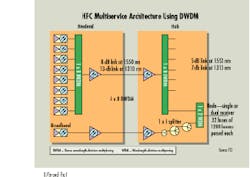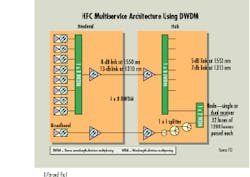tci returns to network development
tci returns to network development
As prices fall, dwdm becomes the transparent choice for the communications company`s new upgrade.
By DONALD T. GALL and MITCH SHAPIRO
After more than a year of restructuring its cable holdings, broadly deploying digital set-top boxes, but doing little in the way of network upgrades, tci Communications (Denver, CO) is gearing up for an ambitious hybrid fiber/coaxial-cable (hfc) upgrade program. One of the goals of the upgrade is to achieve "end-to-end transparency" in the optical portion of its network.
Technology and market trends have given tci increased confidence in the market potential of high-speed data services and "narrowcast" and "on-demand" digital video services. Thus, the company`s network engineering group has focused on developing a highly scalable platform that can cost-effectively evolve to support ever-higher penetration and usage levels for such services.
In the process of evaluating alternative architectures, Oleh Sniezko, tci`s vice president of engineering and winner of the 1997 scte-sponsored Polaris Award for his work in the fiber-optics field, became convinced that the best approach for tci was to deploy dense wavelength-division multiplexing (dwdm) in its hfc networks.
While Sniezko had been considering such an approach for some time, it was only recently, he says, that dwdm costs began to decrease sufficiently to find a place in tci`s network design. The main driver of these cost reductions is the intense demand for dwdm technology for use in long-haul baseband digital-transport networks to support today`s explosion of data traffic. Although hfc networks alone might not drive massive demand for dwdm equipment, observed Sniezko, why not ride the rapid cost- reduction curve driven by another segment of the telecommunications industry?
The result of the marriage of dwdm and hfc networks, according to a paper co-authored by Sniezko and Tony Werner, tci`s executive vice president of engineering and technical operations, is "end-to-end transparency" or "invisible hubs." tci has concluded this approach is the best fit with its business plan and mix of cable holdings.
In the hfc architecture most commonly used during the past few years by major multiservice organizations (msos), signals are delivered from headends or primary hubs to secondary hubs via 1550-nm optics. At the hubs--which may also house Synchronous Optical Network equipment as well as modems, routers, and cache servers for high-speed data services--these 1550-nm optical signals are converted to RF and then back to optical for transport on 1310-nm lasers. The 1310-nm lasers serve perhaps two neighborhood nodes apiece.
According to Sniezko, tci began to reconsider this 1550-to-1310 approach after deploying it in Hartford, CT, where the company simultaneously launched new digital video, voice, and high-speed data services. The result, says Sniezko, was secondary hubs that had mushroomed into large, expensive facilities.
By using dwdm, tci will be able to greatly simplify its secondary hubs (see figure), moving equipment such as routers and servers back to the headend and eliminating the need for the optical-to-RF-to-optical gear that would otherwise be needed at these hubs to deliver narrowcast services. And because it will use dwdm, a passive technology moving quickly down the cost curve, to load up to eight packages of narrowcast quadrature amplitude-modulated digital services onto a single fiber running from the headend to each hub, tci will also be able to achieve savings in both fiber and electronics costs.
One trade-off in this approach is that nodes will either require additional optical receivers or, if combined optically, will experience a certain amount of carrier- to-noise degradation. Thus, while greatly simplifying the hubs compared to more "traditional" hfc designs, the tci approach may involve somewhat more cost and complexity at the node.
At a presentation in May of the paper he and Werner wrote, Sniezko reported that in the few months since the paper was first prepared, dwdm and 1550-nm optoelectronics prices had declined by 10% to 20%, resulting in total incremental system cost cuts of 5% to 10%. tci anticipates that by the end of 1998, these costs will undergo an additional 20% decline.
Though vendors say that employing dwdm on the return path from hubs back to the headend is considerably more expensive today than the more common "frequency-stacking" approach, Sniezko is convinced that the former is the smarter long-term move. It will provide more flexibility to accommodate future upstream traffic growth or changes in upstream frequency assignments.
According to Sniezko and other industry sources, current price quotes for externally modulated narrowcast transmitters are approximately $7500, with quotes for direct-modulated devices in the $5000-to-$6000 range and falling.
In terms of narrowcast transmitters, Sniezko says tci is planning to initially deploy one unit per 10,000 homes, with plans to incrementally add wavelength-specific transmitters as demand warrants. The expectation is that eventually the mso may deploy a dedicated narrowcast transmitter for each 1000 homes it reaches with narrowcast services.
To date, tci has awarded stand-alone projects that combine 1550-nm technology and dwdm to Harmonic Lightwaves and antec for cable systems in Vancouver and Seattle, WA, respectively. At present, both of these vendors employ direct modulation in their 1550-nm narrowcast transmitters, whereas several other vendors appear to be focusing on externally modulated narrowcast devices.
tci`s dwdm rollout plans called for concept testing in May using several hubs, followed by deployment this year of a basic dwdm infrastructure capable of feeding hfc plant in tci systems passing 3.5 million homes.
Other msos to follow?
In terms of the domestic market, tci may go it alone, at least in the near term, in its pursuit of a combination 1550-nm/ dwdm architecture. One reason is that most other major msos are much farther along than tci in their upgrade plans, with a substantial portion of their networks either fully upgraded or well into their design phase based on other approaches to hfc networks.
While most other large operators are pushing hard to get the bulk of their networks upgraded by 2000, the large number of system acquisitions and swaps that have occurred over the past few years could extend the current period of heavy construction activity through 2003. The fact that most of these newly acquired systems will be integrated into existing clusters suggests that when they are upgraded, they will employ the same basic architecture already deployed in other, previously upgraded, portions of these clusters.
Nevertheless, at some point, these msos are likely to find that their narrowcast services--especially bandwidth-hungry video-on-demand (vod)--will require additional capacity in their 1550-nm transport networks. In the early stages of vod rollouts, these msos may be able to load a certain amount of narrowcast traffic on their existing 1550-nm transmitters, which in many cases are being initially loaded with only 40 analog channels per transmitter. This, however, is likely to support only a few percentage points of penetration for vod services. Once this penetration level is exceeded, these msos will need to add capacity to their 1550-nm networks.
Because they have already deployed fiber-rich backbones and traditional hfc networks (i.e., full-blown hubs feeding nodes via 1310-nm lasers), these msos will face different cost equations than tci in terms of the relative value of dwdm solutions.
For example, instead of using dwdm for narrowcast services, these msos may choose to use some of their dark fiber to transport up to four 200-MHz narrowcast digital tiers on broadcast-capable 1550- nm lasers. This approach could support vod penetration up to 20% or even higher. This suggests that these msos may not have a compelling need to adopt dwdm solutions in the foreseeable future, unless vod shows itself to be a very popular high-penetration service.
On the other hand, if the price and performance of dwdm systems continue to improve dramatically, as tci expects, these other msos could begin to shift towards a dwdm migration path even if vod and other narrowcast traffic does not lead them to physically run out of fiber capacity on their 1550-nm transport links. uThe use of dwdm in tci`s hybrid fiber/coaxial-cable upgrade project will allow the company to achieve greater simplicity in its network design as well as lower costs.

